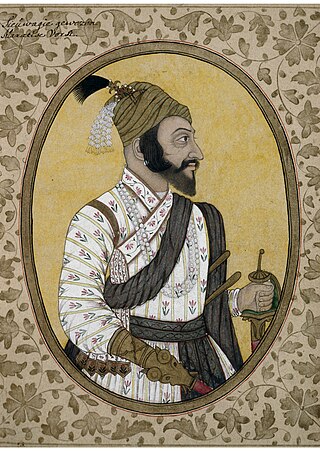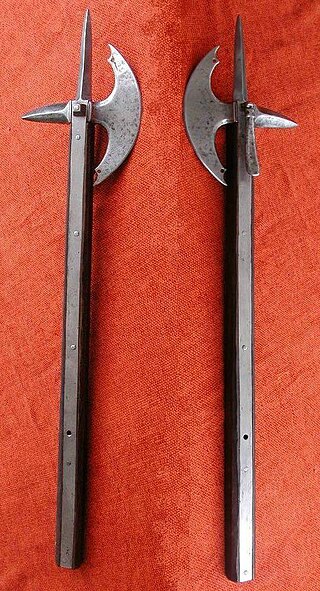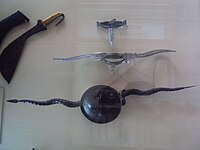
A polearm or pole weapon is a close combat weapon in which the main fighting part of the weapon is fitted to the end of a long shaft, typically of wood, extending the user's effective range and striking power. Polearms are predominantly melee weapons, with a subclass of spear-like designs fit for thrusting and/or throwing. Because many polearms were adapted from agricultural implements or other fairly abundant tools, and contained relatively little metal, they were cheap to make and readily available. When belligerents in warfare had a poorer class who could not pay for dedicated military weapons, they would often appropriate tools as cheap weapons. The cost of training was comparatively low, since these conscripted farmers had spent most of their lives using these "weapons" in the fields. This made polearms the favoured weapon of peasant levies and peasant rebellions the world over.
A spear is a polearm consisting of a shaft, usually of wood, with a pointed head. The head may be simply the sharpened end of the shaft itself, as is the case with fire hardened spears, or it may be made of a more durable material fastened to the shaft, such as bone, flint, obsidian, copper, bronze, iron, or steel. The most common design for hunting and/or warfare, since ancient times has incorporated a metal spearhead shaped like a triangle, diamond, or leaf. The heads of fishing spears usually feature multiple sharp points, with or without barbs.

Shivaji I was an Indian ruler and a member of the Bhonsle dynasty. Shivaji carved out his own independent kingdom from the Sultanate of Bijapur that formed the genesis of the Maratha Confederacy.
The French estoc is a type of sword, also called a tuck in English, in use from the 14th to the 17th century. It is characterized by a cruciform hilt with a grip for two-handed use and a straight, edgeless, but sharply pointed blade around 36 to 52 in in length. It is noted for its ability to pierce mail armor.

Swordsmanship or sword fighting refers to the skills and techniques used in combat and training with any type of sword. The term is modern, and as such was mainly used to refer to smallsword fencing, but by extension it can also be applied to any martial art involving the use of a sword. The formation of the English word "swordsman" is parallel to the Latin word gladiator, a term for the professional fighters who fought against each other and a variety of other foes for the entertainment of spectators in the Roman Empire. The word gladiator itself comes from the Latin word gladius, which is a type of sword.

Banshay is a weapon-based martial art from Myanmar focusing primarily on the sword, staff and spear. Influenced by both Indian and Chinese sources, it is closely related to similar Southeast Asian systems such as Thai krabi krabong, Cambodian kbach kun boran and Malay silat.

A battle axe is an axe specifically designed for combat. Battle axes were designed differently to utility axes, with blades more akin to cleavers than to wood axes. Many were suitable for use in one hand, while others were larger and were deployed two-handed.

The patta is a sword, originating from the Indian subcontinent, with a gauntlet integrated as a handguard. Often referred to in its native Marathi as a dandpatta, it is commonly called a gauntlet-sword in English.

Rajaram I was the third Chhatrapati of the Maratha Kingdom, who ruled from 1689 to his death in 1700. He was the second son of Chhatrapati Shivaji Maharaj, the founder of the empire and younger brother of Chhatrapati Sambhaji Maharaj whom he succeeded. His eleven-year reign was marked with a constant struggle against the Mughals. He was succeeded by his infant son Shivaji II under the regentship of his Rajmata Maharani Tarabai.

Nashik district, formerly known as Nasik district, is a district in Maharashtra, India. The city of Nashik is the administrative headquarters of the district. Nashik is well known for the production of wine. Nashik is also known as Mini Maharashtra, because the climate and soil conditions of Surgana, Peth, Igatpuri resembles with Konkan. Niphad, Sinnar, Dindori, Baglan blocks are like Western Maharashtra and Yeola, Nandgaon, Chandwad blocks are like Vidarbha Region. Nashik is the biggest city in the district while Malegaon is the second biggest city. Manmad, Igatpuri, and Sinnar are some of the big cities situated in the Nashik District. Manmad is one of the biggest railway junctions in India while the city of Malegaon is famous for its powerloom.
Indian martial arts refers to the fighting systems of the Indian subcontinent. A variety of terms are used for the English phrases "Indian martial arts", deriving from ancient sources. While they may seem to imply specific disciplines, by Classical times they were used generically for all fighting systems.

The Deccan wars also known as Maratha war of independence, were a series of military conflicts between the Mughal Empire and the descendants of the Maratha ruler Shivaji from the time of Shivaji's death in 1680 until the death of Emperor Aurangzeb in 1707. Shivaji was a central figure in what has been called "the Maratha insurgency" against the Mughal state. Both he and his son, Sambhaji, or Shambuji, typically, alternated between rebellion against the Mughal state and service to the Mughal sovereign in an official capacity. It was common practice in late 17th-century India for members of a ruling family of a small principality to both collaborate with the Mughals and rebel.

The Battle of Sinhagad, also known as Battle of Kondhana, involved an attack by Marathas during the night of 4 February 1670 on the Mughal fort of Sinhagad, near the city of Pune, Maharashtra. The Marathas captured the fort.

Huiyen Lallong is a traditional Meitei martial art form. It is one of the Indian martial arts, originating from Manipur. In the Meitei language, Huiyen means war while Lallong or Lanlong can mean net, knowledge or art. Huiyen Langlon consists of two main subforms: Thang-Ta and Sarit Sarak. The primary weapons of Huiyen Lallong are the Thang (sword) and Ta (spear). The spear can be used in its non-missile form while up close, or thrown from afar. Other weapons include the shield and the axe. Unarmed combat incorporates hand strikes, kicks, and grappling (Mukna). Because of Manipur's cultural similarity and geographical proximity with Myanmar, huyen langlon is closely related to Burmese bando and banshay.

The Maratha Army was the land-based armed forces of the Maratha Confederacy, which existed from the late 17th to the early 19th centuries in the Indian subcontinent.

Mughal weapons significantly evolved during the ruling periods of its various rulers. During its conquests throughout the centuries, the military of the Mughal Empire used a variety of weapons including swords, bows and arrows, horses, camels, elephants, some of the world's largest cannons, muskets and flintlock blunderbusses.

The three most common types of Chinese polearms are the ge (戈), qiang (槍), and ji (戟). They are translated into English as dagger-axe, spear, and halberd. Dagger-axes were originally a short slashing weapon with a 0.9–1.8 m long shaft, but around the 4th century BC a spearhead was added to the blade, and it became a halberd. The spear is also sometimes called a mao (矛), which is sometimes used to designate polearms with a wavy snake-like spearhead. There was another polearm weapon known as the pi (鈹), translated into English as either sword-staff or long lance, that was used from ancient times until the Han dynasty. It was essentially a short sword attached to a stick. From the Warring States period onward, the length of Chinese polearms varied from around 2.8 to 5.5 m ; however, there is no specific designation for a pike in the traditional Chinese lexicon. A very long spear is just called a long spear.
















